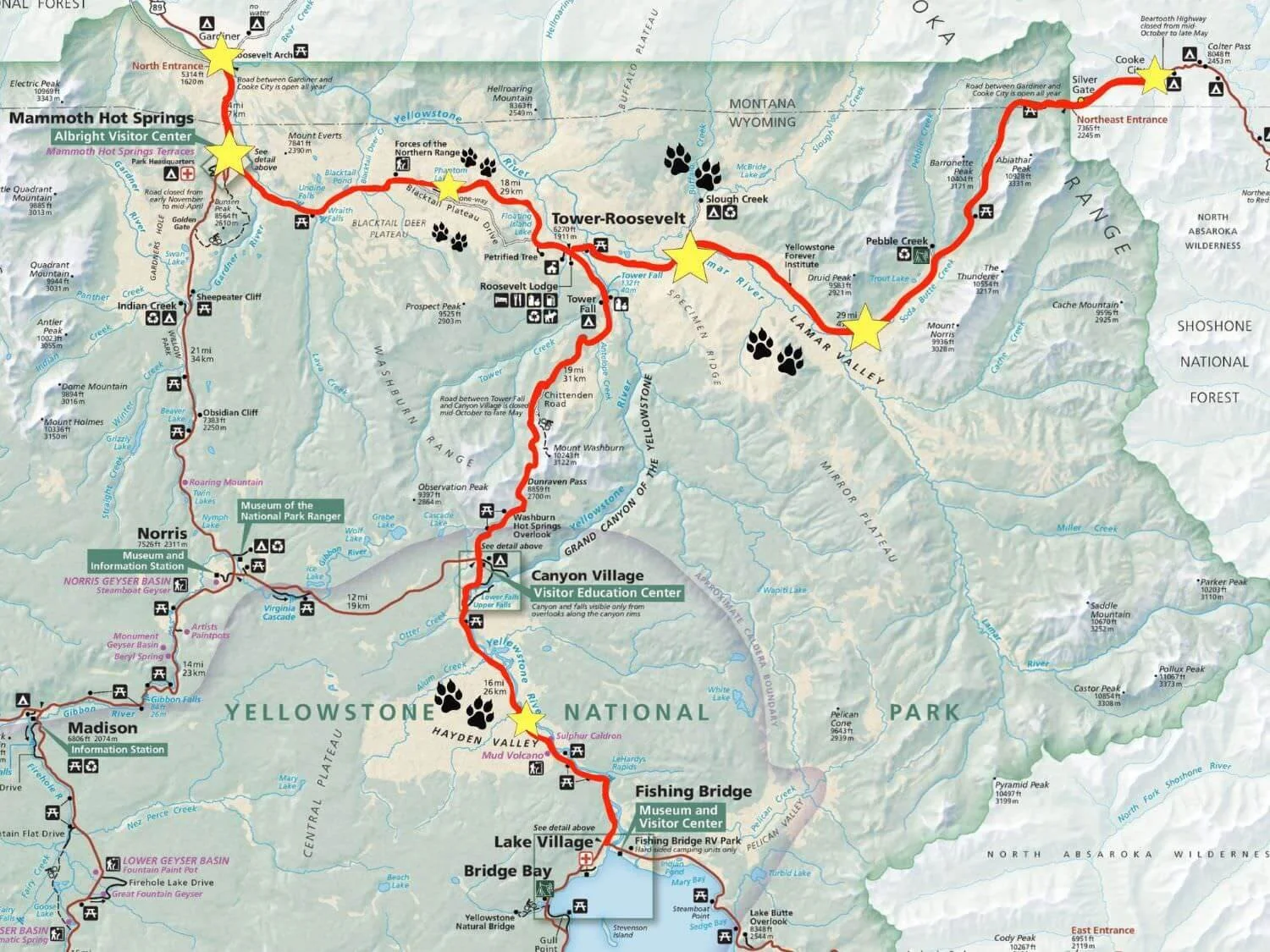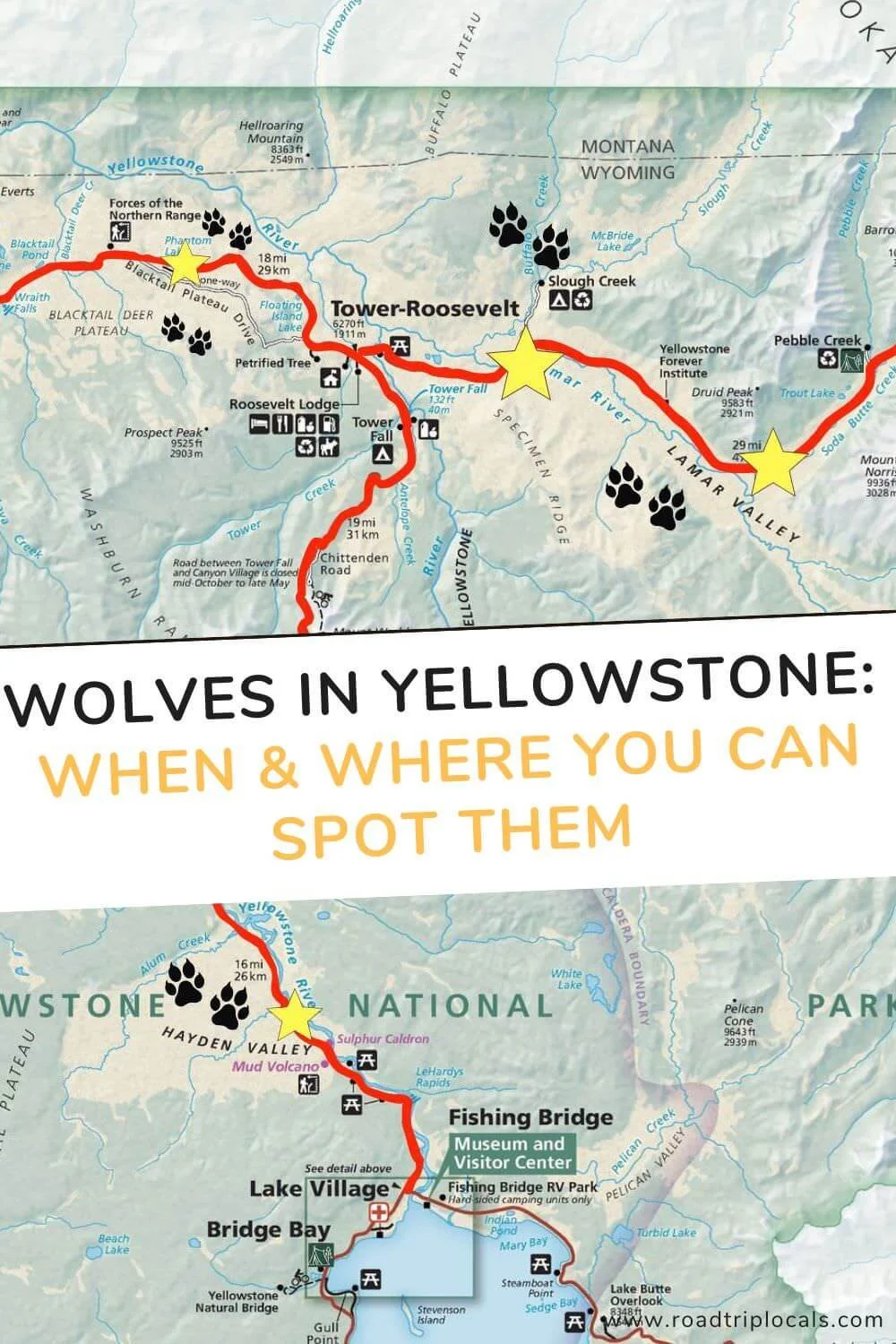Wolves in Yellowstone: When and Where You Can Spot Them
Wolves are one of Yellowstone’s most sought-after wildlife sightings, drawing visitors from around the world. As apex predators, these intelligent and elusive animals roam the park’s vast landscapes, hunting in packs and showcasing fascinating social behaviors. Spotting a wolf in the wild is a thrilling, once-in-a-lifetime experience. Knowing when, where, and how to look improves your odds and helps you have an unforgettable wildlife adventure.
Table of Contents Hide
The Best Time of Year to See Wolves in Yellowstone
Winter (Best Season for Wolf Watching)
Winter is arguably the best season for wolf-watching in Yellowstone National Park. With snow covering the ground, wolves are easier to spot against the white backdrop. They also tend to be more active, hunting elk and other prey in visible areas.
Why is winter great for wolf-watching? Less tree cover, active hunting behavior, and fewer crowds create ideal wolf-spotting conditions.
Best months: December through March, with February being arguably the best winter month.
Spring and Fall (Good for Behavior Observation)
Spring and fall are also excellent times to see wolves. In spring, you might see wolf pups near den sites, while fall offers dramatic pack interactions during the elk rut, as wolves hunt actively.
Best months: April to early June (spring); September to early November (fall). If you’re hoping to spot wolf pups, mid-May through early June is generally best. This is also one of the best times to be in Yellowstone for bear-watching, making this timeframe one of our favorites for wildlife-watching as a whole!
Summer (Harder but Still Possible)
Summer is usually the most challenging time to see wolves, since packs generally move to higher elevations, hunt at night, and are less visible in thick vegetation. Your best bet in summer months is heading out at dawn or dusk—and asking rangers once you arrive about recent sightings.
Packs tend to establish a “daycare site” for young wolf pups, returning to the same spot day after day. In the summer of 2024, this spot for one Yellowstone wolf pack was about a mile off the road in Hayden Valley. The wolf pack—with nine pups—was visible almost daily in the valley (using scopes). Once wolves establish an area for this child-rearing season, they tend to stick to it while the pups grow. Once you get to Yellowstone, ask a ranger where wolves have been spotted recently and head there to see if you can spot them, too!
Best months: Late June through August.
Using a scope to watch wolf pups in Hayden Valley in July.
Where to Spot Wolves in Yellowstone
Here are some of the top locations for wolf-watching in Yellowstone National Park.
1. Lamar Valley
Lamar Valley is the best place to see wolves in Yellowstone. Multiple packs roam the valley, and this wide, open terrain offers great visibility.
Best pullouts: Slough Creek, Hitching Post, Lamar River Bridge
Best time: Early morning (before sunrise) or late evening
2. Hayden Valley
While generally less reliable than Lamar Valley, Hayden Valley is another good location, especially in fall and winter when wolves follow elk herds.
Best pullouts: Grizzly Overlook, Alum Creek
Best time: Early morning or dusk
3. Blacktail Plateau Drive & Northern Range
This area between Mammoth Hot Springs and Tower Junction offers great wolf-watching opportunities, especially in winter.
Best pullouts: Blacktail Creek, Hellroaring Overlook
Best time: Winter mornings
4. Yellowstone’s Northeast Entrance (Cooke City & Silver Gate)
Beyond the park’s official boundaries, wolves are sometimes seen near Cooke City and Silver Gate, MT, especially in winter.
If you're determined to see a wolf in Yellowstone, plan to spend several days wolf-watching. While you might get lucky and spot one unexpectedly—even near places like Old Faithful, where wolves are sometimes spotted during winter months—your best chance comes from dedicating multiple days to tracking the latest sightings and behaviors, then returning to those key locations each morning and evening.
Wolves in Yellowstone Map
Here’s a map of Yellowstone National Park highlighting wolf sighting hotspots in Lamar Valley, Hayden Valley, and the Northern Range. Use pullouts, bring a scope, and arrive early for the best chances of spotting these elusive predators!
Best Times of Day to Spot Wolves
Dawn (Best Time) – Wolves are most active early in the morning, especially before sunrise.
Dusk (Second Best Time) – As the sun sets, wolves begin to move and hunt.
Midday (Least Likely) – Wolves are less active and visible during daylight hours, often resting in tree cover.
Tips for Finding Wolves in Yellowstone
Arrive Before Sunrise—Get to the pullouts before first light for the best chance of seeing active packs.
Use Binoculars or a Spotting Scope—Wolves are often far from the road, and good optics make a huge difference! You can rent scopes from outfitters in Gardiner, MT (near Yellowstone’s North Entrance.)
Look for Crowds with Scopes—If you see a group of people with spotting scopes, there’s a good chance they’ve found wildlife (usually bears or wolves).
Listen for Howling—Early mornings and evenings are the best times to hear wolves calling to each other.
Check with Park Rangers or Wildlife Watchers—Rangers and regular wolf watchers often know where wolves were last seen. The best tip is to simply ask!
Keep Noise to a Minimum—Speak in hushed tones and avoid sudden movements to prevent disturbing wolves and other wildlife.
Turn Off Car Headlights and Engine When Stopping—Bright lights and engine noise can startle wildlife, making them move away from viewing areas.
Stay in Your Car or at Designated Pullouts—Avoid walking along roadsides or approaching animals; use your vehicle as a natural blind.
Our first time spotting wolves in Yellowstone near Blacktail Plateau in February.
What to Pack for Wolf Watching
Spotting Scope (or Binoculars)—Wolves are distant animals, and a high-quality spotting scope makes all the difference. A Vortex Razor HD 20-60x85 or Swarovski ATX 25-60x85 are excellent choices.
Tripod for Your Scope—Holding a scope steady is tough without one, so invest in a sturdy tripod for clearer views.
Warm Clothing in Layers—Yellowstone’s early mornings and evenings can be freezing, even in summer. Wear base layers, an insulated jacket, gloves, and a hat to stay warm.
Waterproof Boots—You may need to step off the road for better views, so waterproof, insulated hiking boots are a great option, especially in winter and spring.
Hand and Foot Warmers (and wool socks)—Helpful for winter wolf watching, as you'll be standing still in freezing temperatures.
Snacks & Hot Drinks—Wolf watching often requires patience, so pack granola bars, trail mix, and a thermos with hot coffee, tea, or cocoa.
Notebook & Map—Many visitors track wolf activity; bring a small notebook to jot down sightings and locations.
Red Light Flashlight—If heading out before sunrise, use a red light flashlight to avoid disturbing wildlife while keeping your vision adjusted to the dark.
Camera with a Long Lens—A 400mm or 500mm telephoto lens is ideal for capturing distant wolves.
Sunscreen & Sunglasses—Even in winter, Yellowstone’s high elevation means strong sunlight reflecting off the snow.
Where to Stay for the Best Wolf-Watching Experience
Gardiner, MT, located at Yellowstone’s North Entrance, is the best basecamp for wolf-watching year-round. It offers easy access to Lamar Valley and the Northern Range, which are prime wolf habitat areas. In winter, when most park roads close, Gardiner provides the only year-round access into Yellowstone, making it the top choice for dedicated wildlife watchers. With local guides, spotting scope rentals, and cozy lodging, Gardiner is the ultimate home base for an unforgettable wolf-watching adventure.
Best Spotting Scopes & Where to Rent or Buy Them
Top Spotting Scopes for Wolf Watching
Vortex Razor HD 20-60x85—Great balance of price and performance.
Swarovski ATX 25-60x85—High-end option with incredible clarity.
Where to Rent a Spotting Scope in Gardiner, MT
Optics Yellowstone LLC—Offers high-quality scope rentals.
Big Sky E-Bike Tours—Offers scope and binocular rentals.
Best Long Lenses for Wolf Photography
Canon RF 100-500mm f/4.5-7.1L (great zoom for mirrorless cameras)
Nikon 200-500mm f/5.6E (excellent for DSLR users)
Sony 200-600mm f/5.6-6.3 G OSS (best for Sony shooters)
Wolf Watching Tours in Gardiner, MT
If you want expert guidance and someone else to worry about the driving & parking while you keep your eyes peeled for wolves, a guided wolf-watching tour is a great option. Guided tours come with spotting scopes, experienced guides, and in-depth knowledge of pack movements.
Here are some wolf-watching-specific tours based out of Gardiner, MT.
Yellowstone Safari Company—Offers wolf, bear, and wildlife safaris from Gardiner, MT, and Bozeman.
Yellowstone Wolf Tracker—Specializes in wolf-focused tours with expert guides.
Yellowstone Forever Wolf Tours—A good option for those looking to support conservation efforts.
A Brief History of Wolves in Yellowstone
Wolves were eradicated from Yellowstone in the 1920s, leading to major ecological imbalances. In 1995 and 1996, wolves were reintroduced, and their presence transformed the park, restoring natural predator-prey relationships. Today, around 90-100 wolves live in Yellowstone, divided into multiple packs.
FAQs About Wolves in Yellowstone
Q: How many wolves are in Yellowstone?
Approximately 90-100 wolves roam the park, split among 8-10 packs.
Q: What is the best month to see wolves in Yellowstone?
February is arguably the best month to see wolves in Yellowstone because wolves are easier to spot against the snow.
Q: How close can you get to a wolf?
You must stay at least 100 yards away, per park regulations. Although every once in a while a wolf crosses a road in Yellowstone, they often stay much further away.
Q: Can you hear wolves howling in Yellowstone?
Yes! Early mornings and evenings are the best times to hear wolf howls echoing through the valleys. Sometimes in winter months, you can hear wolves howling on the rolling hills across from Gardiner, MT.
Keep Planning Your Trip to Yellowstone with our All-Seasons Travel Guide
Plan the ultimate Yellowstone vacation with our All-Seasons Yellowstone Travel Guide! With detailed maps, insider tips, and custom itineraries you won't find anywhere else, our Yellowstone Travel Guide will help you experience the best—and less-traveled—parts of Yellowstone National Park. Take the stress out of planning a vacation to one of America's largest and most diverse national parks and make the most of your time with our comprehensive, easy-to-use travel guide.
Save this for later
Hover over the image below and click on the red “Save” button that pops up in the upper lefthand corner of the image to save this on Pinterest for later. (If you’re on mobile, you might have to tap the image first to see the red ‘Save’ button.)
Happy Travels!
Related Posts
















